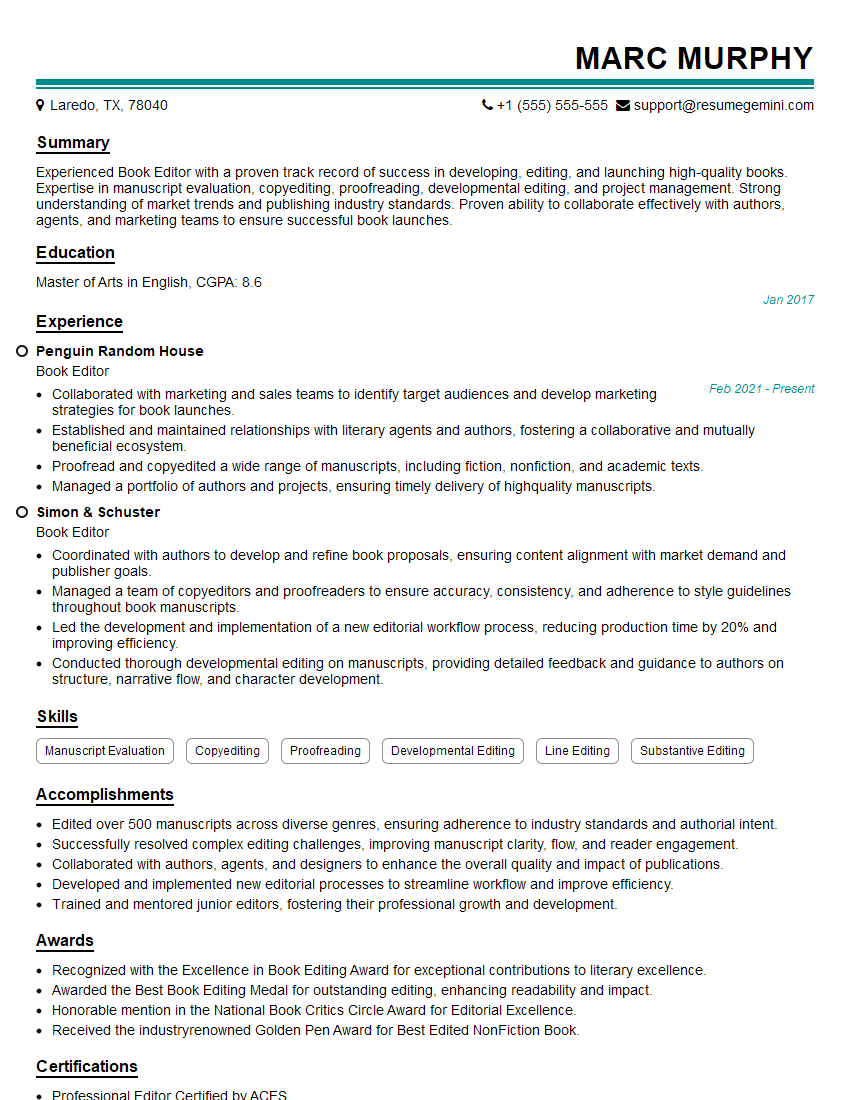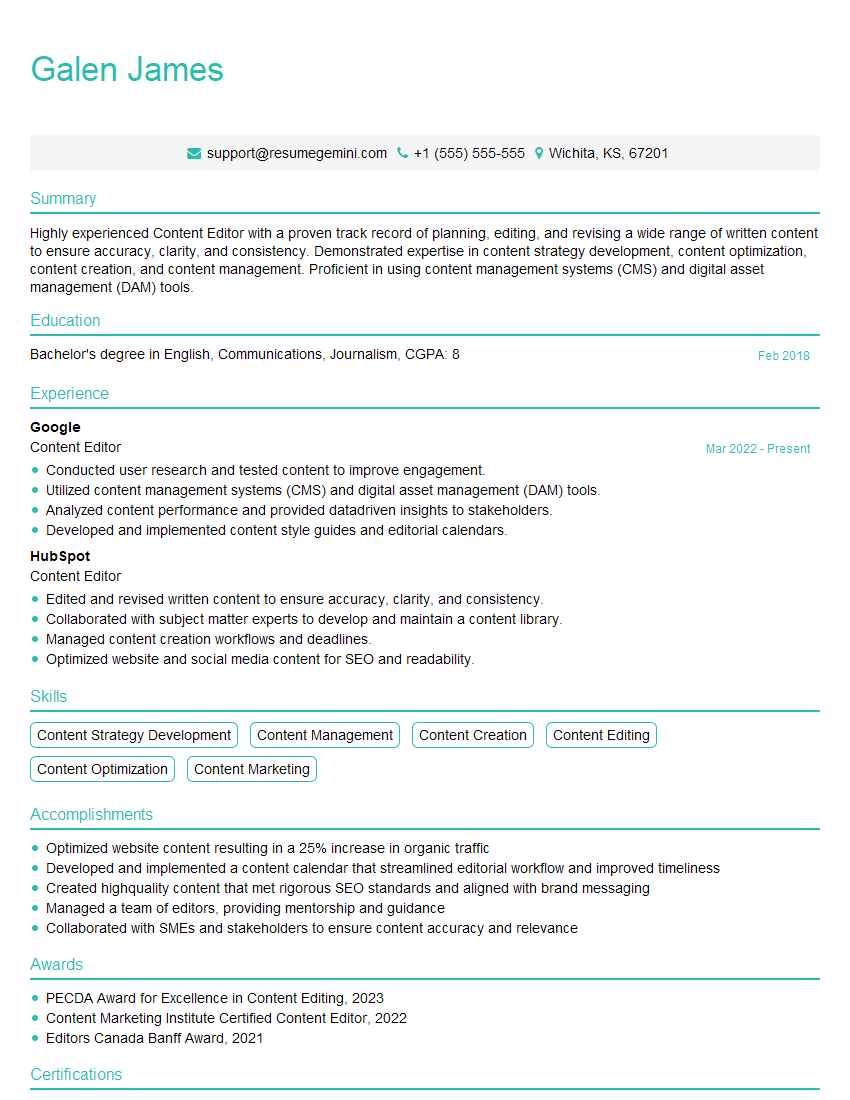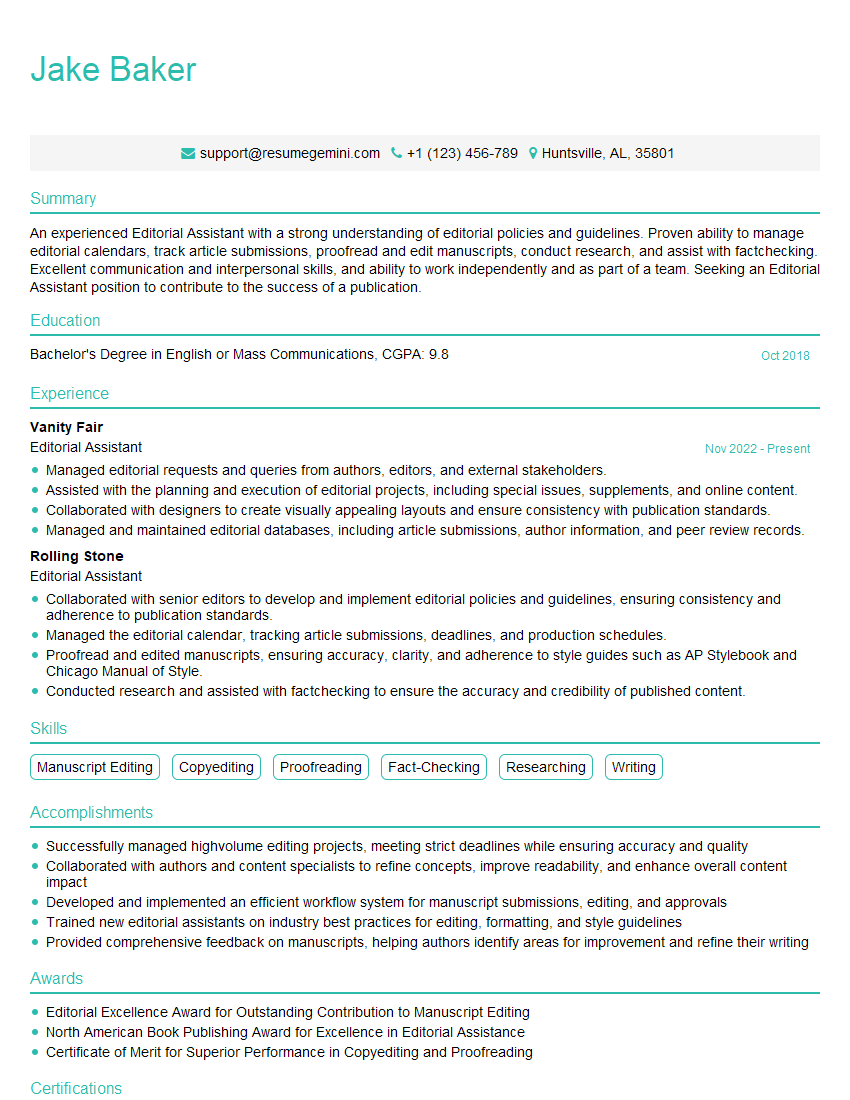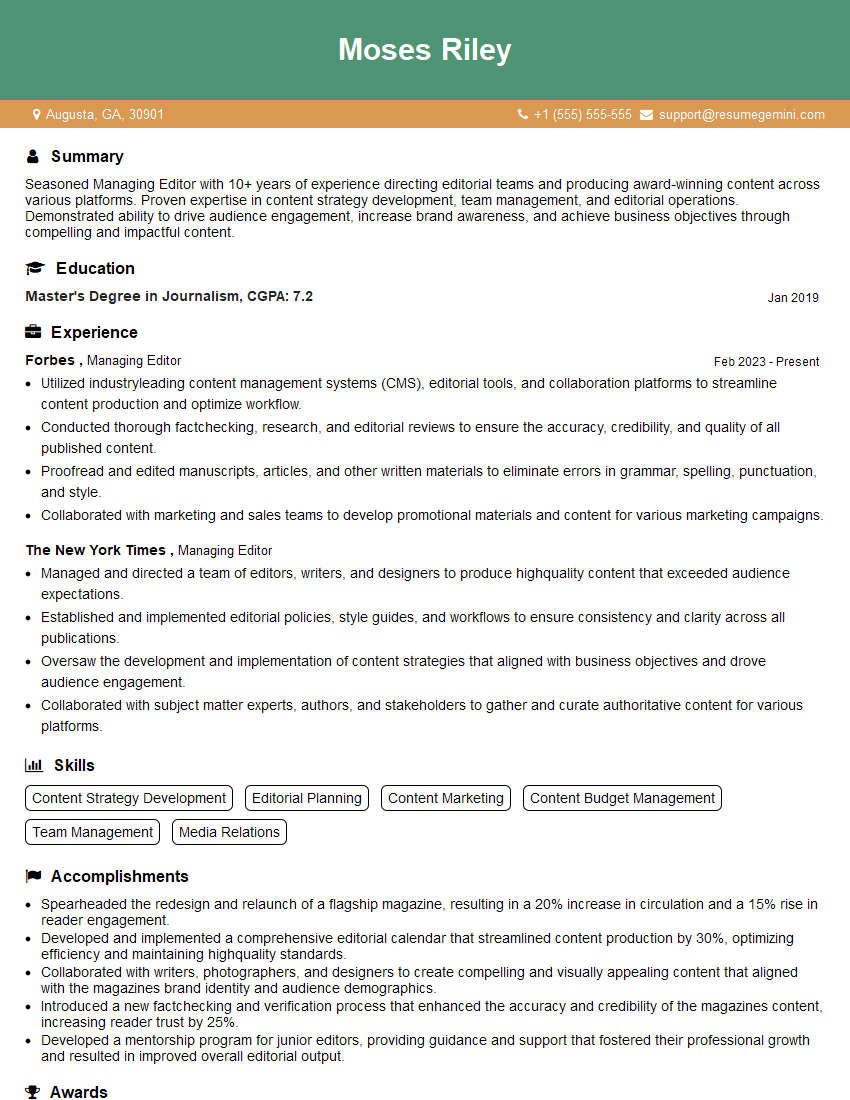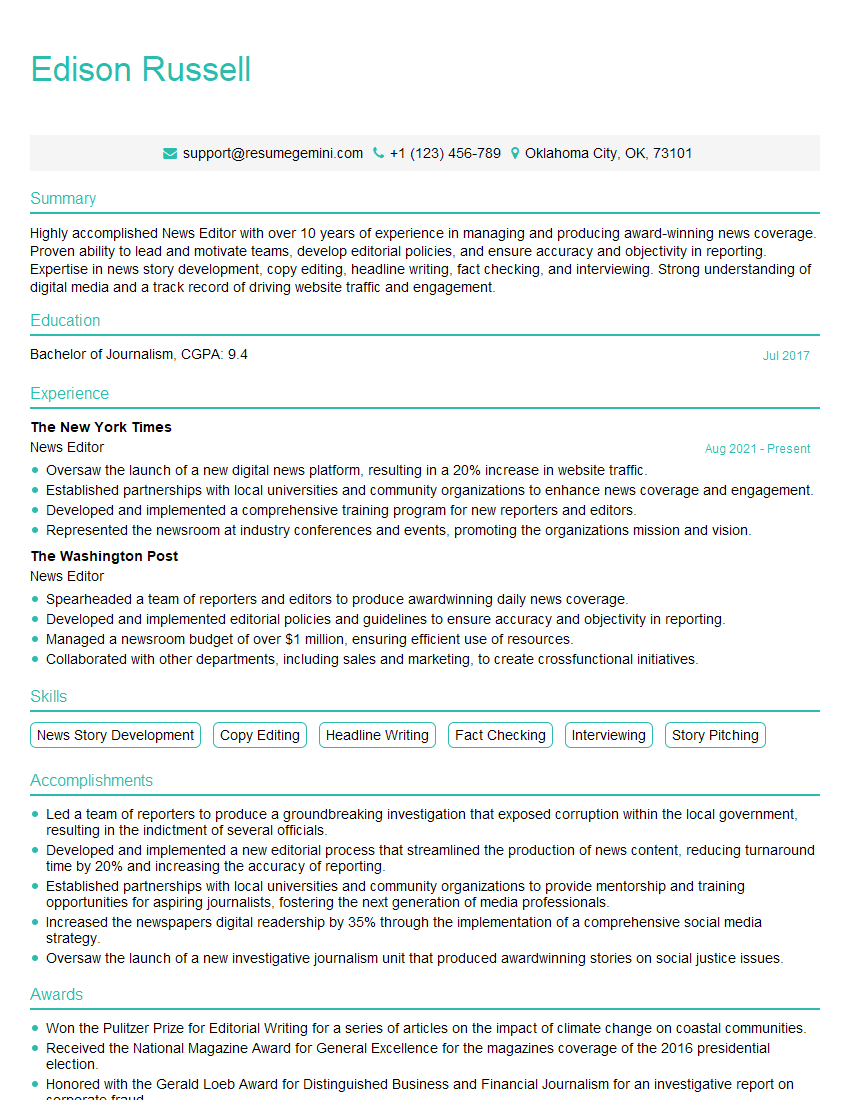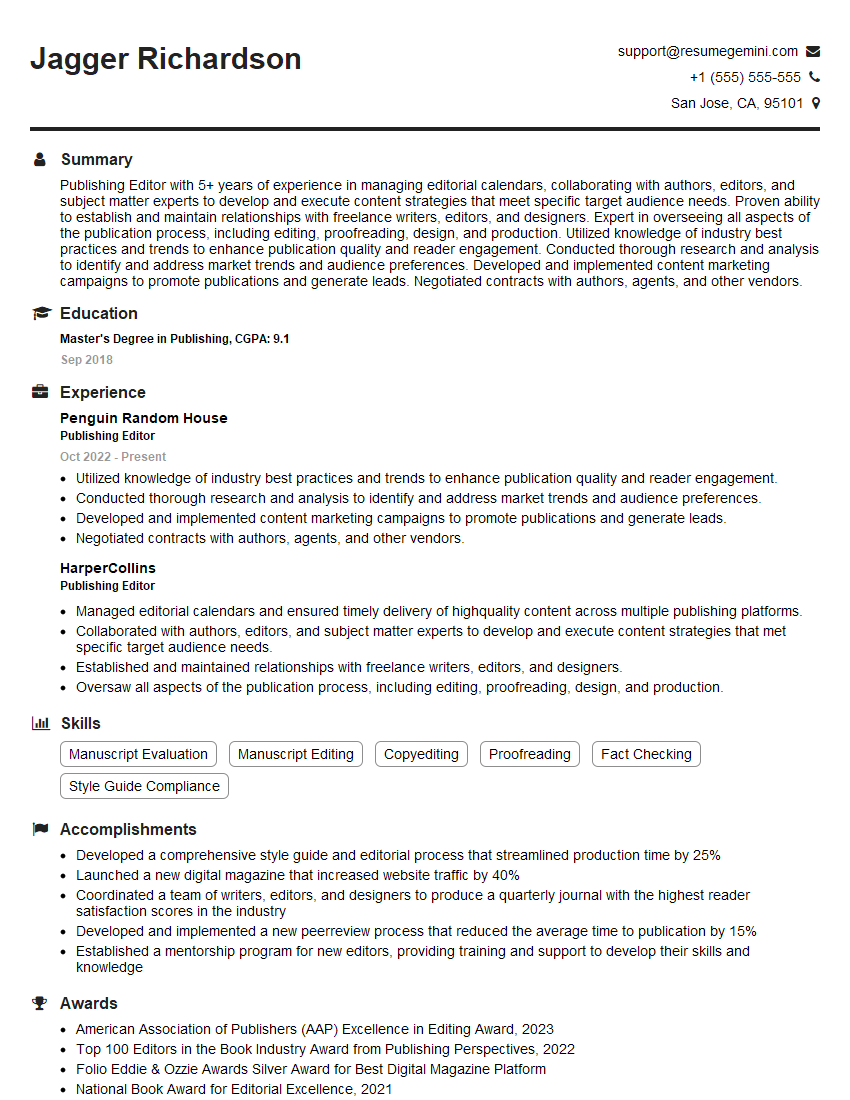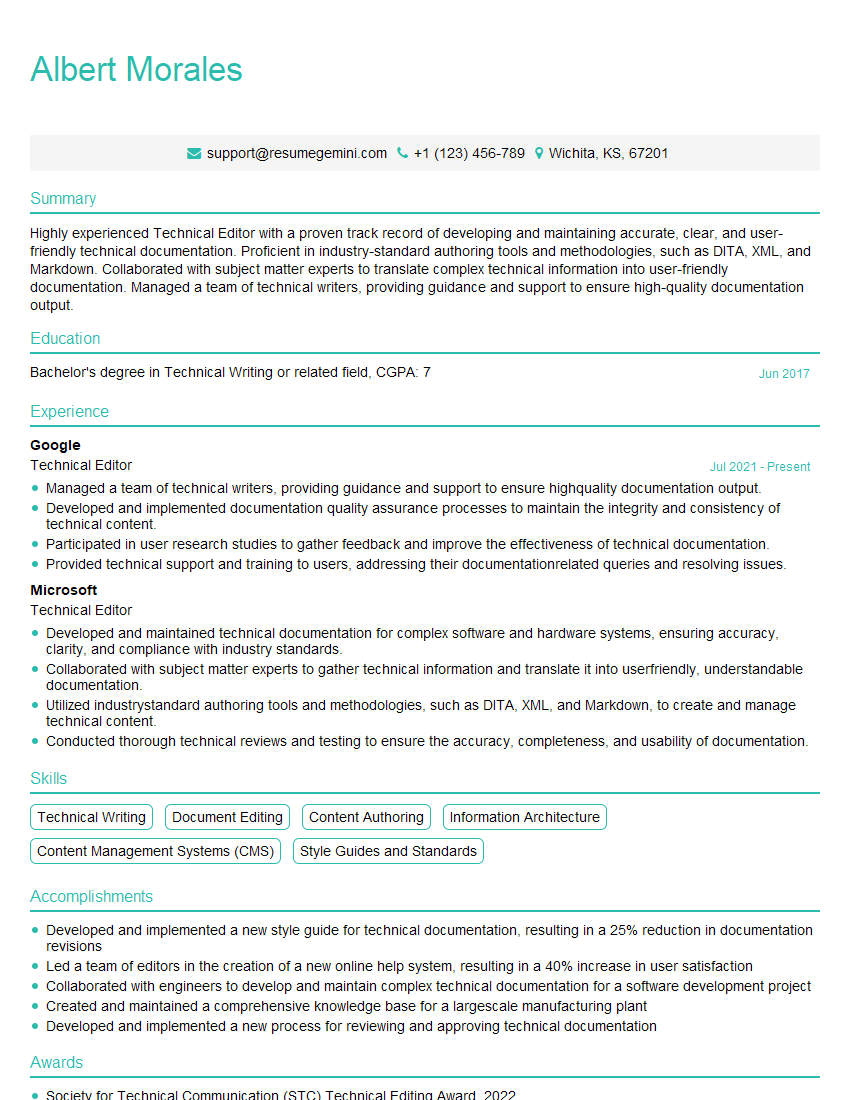The thought of an interview can be nerve-wracking, but the right preparation can make all the difference. Explore this comprehensive guide to Using Editorial Software interview questions and gain the confidence you need to showcase your abilities and secure the role.
Questions Asked in Using Editorial Software Interview
Q 1. What editorial software are you proficient in?
I’m proficient in several editorial software packages, including Adobe InDesign, Microsoft Word, and Scrivener. My experience extends beyond basic word processing; I’m skilled in leveraging the advanced features of each program for efficient and high-quality editorial work. InDesign, for instance, is my go-to for complex layout and design tasks, particularly for publications like brochures or books. Word excels in collaborative editing and simpler document management, while Scrivener’s project management tools are invaluable for large-scale writing projects, allowing me to effectively organize chapters, research notes, and character sketches.
Q 2. Describe your experience with content management systems (CMS).
My experience with Content Management Systems (CMS) is extensive. I’ve worked extensively with WordPress, Drupal, and Contentful. I understand the importance of a well-structured CMS for efficient content creation, workflow management, and publishing. My skills encompass not only content creation and editing within the CMS environment but also the technical aspects, such as user roles, access controls, and plugin management. For example, on a recent project using WordPress, I optimized the site structure to improve SEO, streamlining content delivery for a much broader audience. In another project using Contentful, a headless CMS, I integrated it seamlessly with a custom front-end application, showcasing adaptability across various platforms.
Q 3. How familiar are you with version control within editorial software?
I’m very familiar with version control in editorial software. Understanding version history is crucial for tracking changes, reverting to earlier drafts if needed, and collaborating effectively with others. Most editorial software packages – like Word, InDesign, and even Google Docs – offer built-in version history features. I utilize these diligently, regularly saving different versions with descriptive names (e.g., “Draft 1,” “Revision after feedback,” “Final version”). This allows for easy comparison, rollback, and clear documentation of the editing process. It’s like having a detailed timeline of the document’s evolution, ensuring accountability and efficient revision management.
Q 4. Explain your workflow for editing and proofreading using your preferred software.
My workflow usually begins with a thorough first read of the document to understand the content and identify the overall structure. Then, I move to a line-by-line edit, focusing on grammar, punctuation, style consistency, and clarity. I use track changes extensively to document all edits made. Following the editing phase comes proofreading, a careful second pass focusing on catching any remaining errors. I frequently use a combination of tools, such as a style guide and grammar checker (like Grammarly), to ensure consistency and accuracy. For complex documents, I sometimes break down the workflow into smaller chunks, tackling each section individually, ensuring greater focus and precision. Finally, I thoroughly review the tracked changes before accepting them, ensuring all edits are correct and improve the quality of the manuscript.
Q 5. How do you handle multiple versions of a document in your editorial software?
Handling multiple versions is a breeze thanks to the version history features in my preferred software. As mentioned earlier, I meticulously save each version with a clear, descriptive filename. This avoids confusion. Within the software itself (like Word or InDesign), I can easily compare different versions, highlighting changes and making informed decisions about which edits to keep or discard. If there are truly conflicting versions, I create a new document, combining the best elements from each to create a unified and improved final version. This approach helps me maintain a clear and organized record of all revisions.
Q 6. How do you ensure consistency in style and formatting using editorial tools?
Maintaining style and formatting consistency is critical. I leverage style guides – whether client-provided or established stylebooks (like the Chicago Manual of Style or AP Stylebook) – as a central reference throughout the editing process. In software like InDesign, I use stylesheets to define consistent formatting across headings, body text, and other elements. For documents in Word, I make use of the built-in style features. This automation means that any style changes made in one place are automatically reflected throughout the document, guaranteeing consistency. Using Find & Replace with formatting options is also a valuable technique to quickly enforce uniformity in styles.
Q 7. Describe your experience with collaborative editing features.
I have extensive experience with collaborative editing. I’m comfortable using the built-in collaboration features in Google Docs, Microsoft Word (with co-authoring), and Adobe InDesign’s collaborative capabilities (using tools like shared cloud storage and version control). I appreciate the efficiency of real-time co-editing, allowing for quick feedback and iterative improvement. However, I also recognize the potential for conflicts and miscommunication, and I emphasize clear communication and a well-defined workflow among collaborators to avoid these issues. Using comments features for feedback is key, allowing for a clear record of changes discussed and the reasoning behind them.
Q 8. What are some common challenges you’ve faced using editorial software, and how did you overcome them?
One of the biggest challenges I’ve faced is managing conflicting revisions in collaborative projects. Imagine three editors working simultaneously on the same document – it’s easy for changes to overwrite each other, creating a confusing mess. To overcome this, I rely heavily on version control features within the software. This allows me to track each editor’s contributions individually, compare different versions, and easily revert to earlier states if necessary. I also enforce clear communication protocols within the team, ensuring everyone knows who’s working on which section to minimize overlaps and confusion. Another challenge is dealing with software glitches or incompatibility issues. For instance, I once encountered a bug where image placement was erratic across different browsers. The solution involved thoroughly investigating the software’s documentation, searching for community forums for similar reported issues, and even contacting the software support team. Often, a simple update or a workaround within the software’s settings resolved the problem.
Q 9. How do you use editorial software to track changes and feedback?
Tracking changes and feedback is crucial for effective editorial workflows. Most editorial software offers robust tools for this. For instance, the ‘track changes’ feature allows me to see precisely what edits have been made, who made them, and when. This is invaluable when reviewing drafts and ensuring that all feedback has been considered. Further, comment features allow for threaded discussions directly within the document itself. This helps streamline communication and maintains a clear audit trail. I often use a color-coding system to visually separate different types of feedback (e.g., style edits in blue, factual corrections in red, and suggestions in green). This makes reviewing and implementing feedback far more efficient. For larger projects with multiple reviewers, the software’s ability to generate reports summarizing all changes and comments is invaluable.
Q 10. Explain your approach to using style guides within editorial software.
My approach to using style guides within editorial software hinges on creating and importing custom style sheets. Many editorial programs allow for the creation of custom style sheets based on the organization or publication’s style guide. This eliminates manual formatting and ensures consistency throughout the document. For instance, I might define specific styles for headings, body text, captions, and citations, reflecting the precise formatting rules outlined in the style guide. This automation significantly reduces errors and ensures that the final product is stylistically consistent. If the software doesn’t support custom style sheets, I use find-and-replace functions with caution, ensuring I’ve reviewed all instances carefully to prevent unintended changes. I also regularly check my work against the style guide to ensure all the rules are being followed.
Q 11. How familiar are you with automated grammar and style checking tools?
I’m very familiar with automated grammar and style checking tools. These tools are extremely useful for catching minor errors and inconsistencies, but I treat them as aids, not replacements for a thorough human review. For example, tools like Grammarly or ProWritingAid are excellent for identifying grammatical errors, spelling mistakes, and potential style inconsistencies. However, I’m always aware of their limitations. They might flag correct usage as an error or miss nuances in context. Therefore, I always proofread manually after using these tools, focusing on areas where the tool flagged a potential issue to ensure that I don’t overlook anything.
Q 12. How do you ensure the accuracy of data and information within your edits?
Ensuring data accuracy is paramount. My approach involves multiple layers of verification. First, I meticulously cross-reference all data with original sources. This includes fact-checking statistics, figures, and quotations using reputable references. Next, I utilize the software’s features for data validation. Many programs have built-in tools for checking data integrity and consistency. Finally, where possible, I seek a second pair of eyes to review the data. A second reviewer can offer an independent perspective and catch errors that I might have overlooked. For instance, when working on a report with numerous statistics, I’d have a colleague verify the accuracy of calculations and the consistency of data presentation. This layered approach significantly minimizes the risk of publishing inaccurate information.
Q 13. Describe your experience with exporting content from editorial software to different formats.
Exporting content to various formats is a regular part of my workflow. I’m proficient in exporting to common formats like DOCX, PDF, HTML, and XML. The process usually involves selecting the appropriate export option within the software and configuring settings according to the specific needs. For example, when exporting to PDF, I might adjust settings to optimize for print or screen viewing. When exporting to HTML, I might need to ensure compatibility with specific content management systems (CMS). I always preview the exported file to ensure that formatting, images, and links are rendered correctly. This careful review helps avoid issues like broken links, missing images, or garbled text in the final output.
Q 14. Have you used editorial software for creating and managing digital assets?
Yes, I have extensive experience using editorial software for creating and managing digital assets. Many modern platforms integrate directly with digital asset management (DAM) systems. This allows me to link and manage images, videos, and other multimedia content directly within the editorial document. Features like image galleries or embedded media players within the software streamline this process. This integration simplifies content creation, ensuring all assets are organized and easily accessible. For instance, in creating an online magazine, the software’s ability to manage all assets within a centralized workspace significantly improves workflow efficiency and collaboration. The ability to track asset usage and versions is also critical, especially for large team projects where multiple people might be accessing and modifying the same assets.
Q 15. How do you manage large volumes of content using editorial software?
Managing large volumes of content effectively in editorial software hinges on organization and leveraging the software’s features. Think of it like managing a large library – you wouldn’t just throw all the books into one pile! Instead, you’d categorize them, use a cataloging system, and potentially even employ a digital library management system. Editorial software provides similar tools.
- Content Categorization: I utilize robust folder structures and tagging systems within the software to categorize content by topic, project, status (e.g., draft, in review, published), and author. This makes finding specific pieces of content incredibly easy. For example, I might have a folder for ‘Marketing Materials,’ with subfolders for ‘Blog Posts,’ ‘Social Media Content,’ and ‘Email Campaigns,’ each further organized by date or project.
- Content Versioning: Editorial software with version control is crucial. This allows me to track changes, revert to previous versions if necessary, and see the evolution of a document. It’s like having a time machine for your content! Imagine mistakenly deleting a crucial paragraph; version control allows you to easily restore it.
- Search and Filtering: Mastering the software’s search and filter functions is paramount. I can quickly locate specific content based on keywords, metadata, author, or date. This saves countless hours compared to manually sifting through files.
- Collaboration Tools: Many editorial platforms facilitate collaborative workspaces. This helps manage multiple contributors and projects simultaneously, ensuring everyone has access to the relevant materials while maintaining a clear overview of the workflow.
Career Expert Tips:
- Ace those interviews! Prepare effectively by reviewing the Top 50 Most Common Interview Questions on ResumeGemini.
- Navigate your job search with confidence! Explore a wide range of Career Tips on ResumeGemini. Learn about common challenges and recommendations to overcome them.
- Craft the perfect resume! Master the Art of Resume Writing with ResumeGemini’s guide. Showcase your unique qualifications and achievements effectively.
- Don’t miss out on holiday savings! Build your dream resume with ResumeGemini’s ATS optimized templates.
Q 16. Explain your experience with workflow automation in editorial software.
Workflow automation in editorial software is a game-changer, streamlining tasks and significantly boosting efficiency. Imagine a factory assembly line, where each step is automated to optimize production. Editorial workflow automation does the same for content creation and publishing.
- Automated routing: I configure automated routing to send content to the appropriate reviewers or editors based on pre-defined rules (e.g., all blog posts go to the content editor, all press releases go to the PR manager). This eliminates manual forwarding and ensures timely review.
- Automated notifications: The software automatically notifies relevant parties when a task is assigned, completed, or requires attention. This helps maintain transparency and accountability, preventing bottlenecks.
- Automated publishing: Many systems allow scheduling content for automatic publishing at a specific date and time. This is extremely valuable for consistent content delivery across multiple platforms.
- Customizable workflows: I tailor workflows to suit specific project needs. For instance, a simple blog post might have a two-step review process, while a complex whitepaper could involve several stages of review and editing.
In a recent project, I automated the approval process for blog posts, reducing the turnaround time from days to hours. The system automatically assigned posts to editors, sent reminders for review, and notified the marketing team once approved for publication.
Q 17. How proficient are you in using search and replace functions effectively?
Proficiency in search and replace functions is essential for efficient editing. It’s like having a powerful magnifying glass and a precise editing tool all in one.
I’m highly proficient in using regular expressions (regex) for advanced search and replace operations. This allows me to find and replace patterns within text, rather than just literal strings. For instance, I can quickly replace all occurrences of inconsistent date formats (e.g., 01/01/2024, Jan 1, 2024) with a standardized format using a single regex command.
A simple example would be replacing all instances of “colour” with “color” throughout a document. A more complex example would be using regex to find and replace all email addresses to obfuscate them before publishing.
Beyond simple find and replace, I understand the importance of previewing changes before applying them, especially when using regex, to avoid unintended consequences.
Q 18. Describe your experience with using templates and styles in editorial software.
Templates and styles are fundamental for maintaining consistency and efficiency in content creation. Think of them as pre-designed blueprints and formatting guidelines for your documents.
- Templates: I use templates to create a standardized structure for different types of content. For instance, I have separate templates for blog posts, press releases, and case studies, each with pre-defined sections, headings, and formatting. This saves time and ensures a consistent look and feel across all content.
- Styles: Styles define the formatting for specific elements within a document (e.g., headings, body text, quotes). Using styles ensures consistency in font sizes, spacing, and other formatting attributes. Changes to a style are automatically applied across the entire document, avoiding tedious manual adjustments.
For example, I might create a style for ‘Heading 1’ that automatically sets the font size to 24pt and makes the text bold. If I later decide to change the font, I only need to modify the style once, and the change applies to all ‘Heading 1’ elements throughout the document.
Q 19. How do you handle conflicting edits from multiple contributors?
Handling conflicting edits from multiple contributors requires a systematic approach and leveraging the collaborative features of the editorial software. Think of it as a collaborative orchestra, where each musician plays their part, and the conductor (the editorial software) ensures harmony.
- Version Control: The software’s version control is crucial here. It allows me to see who made which changes and when, making it easy to identify conflicts and address them methodically.
- Commenting and Tracking: Using the software’s commenting and annotation features, I can communicate with contributors about conflicting edits. This facilitates a discussion and helps reach a consensus.
- Merging Changes: Most editorial software provides tools for merging conflicting edits. I carefully review the merged version to ensure it reflects the intended changes and that no unintended edits have been introduced.
- Clear Communication: Open communication with contributors is key. Establishing clear guidelines and providing feedback promptly helps prevent conflicts and streamlines the review process.
Q 20. What steps do you take to ensure the accessibility of your edited content?
Ensuring the accessibility of edited content is critical for inclusivity. It’s about making the content usable for everyone, regardless of their abilities. This includes people with visual, auditory, motor, or cognitive impairments.
- Using Heading Structure: Proper use of heading tags (H1, H2, H3, etc.) helps screen readers navigate the content. This allows visually impaired users to understand the document’s structure.
- Alt Text for Images: Providing descriptive alt text for all images ensures that screen readers can convey the image’s content to visually impaired users.
- Color Contrast: Ensuring sufficient color contrast between text and background is vital for readability. Tools within the software often flag low contrast.
- Keyboard Navigation: Content must be navigable using only a keyboard. This allows users with motor impairments to access the content.
- Structured Content: Using structured content and adhering to accessibility guidelines like WCAG (Web Content Accessibility Guidelines) ensures that the content is semantically correct and accessible to assistive technologies.
I routinely use accessibility checkers built into the software or use external tools to identify and fix accessibility issues before publishing content.
Q 21. How do you utilize editorial software for SEO optimization?
Editorial software can significantly aid in SEO optimization. Think of it as a powerful toolbox for improving your content’s visibility in search engine results.
- Keyword Integration: The software can assist in identifying and integrating relevant keywords naturally within the content. This improves search engine ranking by ensuring your content aligns with search queries.
- Metadata Management: Many platforms allow managing metadata (title tags, meta descriptions, etc.), which are essential for search engine optimization. They are the content’s digital passport, describing it to search engines.
- Content Optimization Tools: Some platforms integrate tools that provide insights into content readability, keyword density, and other SEO factors. These tools help to optimize content for search engines.
- Link Management: Managing internal and external links efficiently is crucial for SEO. Editorial software allows for organized link insertion and management, aiding in content linking strategy.
For instance, I often use the built-in SEO tools to check keyword density, readability scores, and meta descriptions before publishing. This iterative process allows me to optimize content to target specific keywords and improve its visibility in search results.
Q 22. How familiar are you with using editorial software for multilingual content?
My experience with multilingual content in editorial software is extensive. I’ve worked with platforms like SDL Trados Studio, memoQ, and even integrated custom solutions within CMS systems. The key to effective multilingual workflow isn’t just knowing the software, but understanding the nuances of localization. This includes managing translation memory, terminology databases, and quality assurance processes. For example, I’ve successfully managed projects involving simultaneous translation and review across multiple languages for large-scale marketing campaigns, ensuring consistent branding and messaging across different cultural contexts. I’m proficient in handling various file formats, including .docx, .pdf, .xml, and industry-standard translation memory formats.
Beyond the technical aspects, a deep understanding of cultural sensitivities and linguistic differences is crucial. This ensures not only accurate translation but also culturally appropriate content. For instance, I once identified a subtle difference in phrasing in a Japanese translation that had the potential to cause confusion. A quick adjustment prevented a potential marketing disaster.
Q 23. What is your experience with integrating editorial software with other business tools?
Integrating editorial software with other business tools is paramount for streamlined workflows. I’ve extensively used APIs and custom integrations to connect editorial platforms (such as WordPress, Contentful, or even proprietary CMS) with project management tools like Asana or Jira, marketing automation platforms like HubSpot, and analytics dashboards like Google Analytics. This allows for a seamless flow of information, automating tasks such as content scheduling, performance tracking, and reporting.
For example, I’ve set up automated workflows where content approved in the editorial software is automatically scheduled for publication on the website and simultaneously updates associated marketing campaigns in HubSpot. This avoids manual data entry, reducing the risk of errors and significantly improving efficiency. Understanding the limitations and capabilities of each API is crucial for a successful integration. I’m comfortable working with both RESTful and GraphQL APIs, as well as custom scripting solutions when needed.
Q 24. Describe your approach to troubleshooting technical issues in editorial software.
My approach to troubleshooting is systematic and data-driven. I begin by replicating the issue to understand the exact context and any error messages displayed. I then consult the software’s documentation, online forums, and knowledge bases for potential solutions. If the issue is specific to my setup, I’ll check system logs for errors and analyze the environment (hardware specifications, software versions, network connectivity).
If the problem persists, I systematically isolate the variables – disabling plugins, reverting to previous versions of the software, or testing on a different environment. I prioritize escalating complex issues to the support team only after exhausting all other avenues and providing them with detailed logs and replication steps. Think of it like a detective investigating a crime – meticulously gathering evidence to solve the mystery. Effective communication with the support team is critical, ensuring they have the necessary context to understand and resolve the problem effectively.
Q 25. How do you stay up-to-date with new features and updates in your preferred editorial software?
Staying current is a priority. I regularly check for updates through the software’s official channels, including release notes, newsletters, and community forums. I participate in online webinars and attend industry conferences, which offer valuable insights into new features and best practices. I also actively engage with online communities, forums, and groups to discuss new functionalities and troubleshoot any emerging issues. This proactive approach ensures that I’m always familiar with the latest capabilities and techniques, optimizing my workflow and leveraging the most recent advancements offered by the software.
Subscription to industry publications and blogs dedicated to editorial software and content management systems is also essential to maintaining an up-to-date understanding of the evolving landscape. This proactive approach ensures I’m not only proficient in the current version but also anticipating future trends and preparing for upcoming releases.
Q 26. Can you describe your experience with using editorial software for content scheduling and publishing?
Content scheduling and publishing are core to my workflow. I utilize the scheduling functionalities within my chosen editorial software to plan and automate content deployment across multiple platforms. For example, I’ve successfully managed complex content calendars with simultaneous publishing to websites, social media accounts, and email marketing platforms. This typically involves configuring automated workflows that automatically publish content at predetermined times, incorporating version control to ensure the right version of the content is published and managing content approvals and reviews within the system.
One project involved managing a series of blog posts scheduled across several months, integrating with social media posting tools for automated promotion. This approach not only ensures consistent content delivery but frees up time for other strategic tasks. Careful planning and understanding of the software’s capabilities are essential for successful content scheduling and publishing operations.
Q 27. How do you assess the quality and effectiveness of your work using editorial software?
Assessing the quality and effectiveness of my work goes beyond simply using the software’s features. I use a multi-faceted approach to evaluate my performance. First, I perform a thorough self-review, examining for errors in grammar, style, and consistency with brand guidelines. I then use analytics from integrated tools (if available) to measure the performance of the published content. This includes tracking metrics such as website traffic, social media engagement, and conversion rates. The goal is to understand the impact of the content and identify areas for improvement.
Feedback from stakeholders and users is invaluable in assessing effectiveness. I actively solicit feedback and incorporate it into subsequent projects to improve content quality and the overall editorial process. Regularly reviewing analytics and incorporating feedback creates a continuous improvement loop. It’s about constant evolution and refinement based on data and practical experience.
Q 28. How do you prioritize tasks and manage your time effectively when using editorial software?
Effective time management is crucial. I employ project management techniques such as time blocking and prioritization matrices (like Eisenhower Matrix) to allocate my time effectively. I leverage the editorial software’s functionalities to create task lists, assign deadlines, and track progress on various projects. This enables me to manage my workload efficiently and ensures timely completion of tasks. For example, I break down large projects into smaller, manageable tasks to improve focus and prevent overwhelm.
The key is to streamline my workflow, automating repetitive tasks and using features like templates and pre-defined styles. Regular review of my schedule and adaptation to changing priorities is also important. It’s not just about using the software, but about using it strategically and efficiently to manage time and tasks effectively.
Key Topics to Learn for Using Editorial Software Interview
- Software Proficiency: Demonstrate a deep understanding of your chosen editorial software (e.g., Adobe InDesign, QuarkXPress, Scribus). This includes mastery of basic and advanced features.
- Workflow Optimization: Showcase your ability to manage complex projects efficiently, utilizing features like templates, styles, and automation tools to streamline the editing process.
- File Management & Collaboration: Explain how you handle various file formats, version control, and collaborative workflows within the software, including cloud-based solutions.
- Layout & Design Principles: Discuss your understanding of typography, visual hierarchy, and effective layout techniques to create visually appealing and easily readable documents.
- Image Editing & Integration: Illustrate your knowledge of working with images within the software, including resizing, color correction, and appropriate placement for optimal visual impact.
- Proofreading & Quality Control: Explain your meticulous approach to ensuring accuracy and consistency in final outputs, highlighting your attention to detail and ability to identify and correct errors.
- Troubleshooting & Problem-Solving: Be prepared to describe how you approach and resolve technical issues or unexpected challenges that arise during the editorial process.
- Understanding Client Needs: Articulate your ability to interpret client briefs and translate them into effective editorial solutions, adapting your approach to different project requirements.
Next Steps
Mastering editorial software is crucial for career advancement in publishing, design, and communication fields. A strong command of these tools directly translates into increased efficiency, higher-quality output, and greater job satisfaction. To maximize your job prospects, create an ATS-friendly resume that highlights your skills effectively. ResumeGemini is a trusted resource to help you build a professional resume that showcases your expertise. Examples of resumes tailored to Using Editorial Software are available to help you get started.
Explore more articles
Users Rating of Our Blogs
Share Your Experience
We value your feedback! Please rate our content and share your thoughts (optional).
What Readers Say About Our Blog
Interesting Article, I liked the depth of knowledge you’ve shared.
Helpful, thanks for sharing.
Hi, I represent a social media marketing agency and liked your blog
Hi, I represent an SEO company that specialises in getting you AI citations and higher rankings on Google. I’d like to offer you a 100% free SEO audit for your website. Would you be interested?

